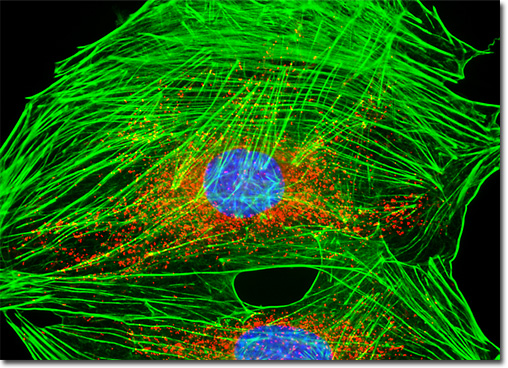Fluorescence Digital Image Gallery
Embryonic Swiss Mouse Fibroblast Cells (3T3)
|
At the time of their establishment, 3T3 cells were different than most other cell lines in regard to the fact they did not induce tumors to develop when injected into murine species. However, 3T3 cells, it was quickly realized, were not normal cells either, since they are capable of growing indefinitely. In fact, the unusual behavior of the line enabled researchers to make a clear distinction for the first time between immortal cells and cells that have the ability to form tumors; previous to studies of the 3T3 line, it was believed that these characteristics were necessarily synonymous with one another. However, due to examination of 3T3 cells and subsequent research it has become widely accepted that for immortalization of cells to take place, telomere shortening, which can instigate chromosomal rearrangements, must be overcome, a process that is not necessarily related to a cellís ability to undergo oncogenic transformation. Presented in the digital image featured above is an adherent culture of Swiss mouse embryo fibroblasts that was immunofluorescently labeled with Rhodamine Red conjugated to antibodies directed against peroxisomal membrane protein 70 (PMP 70), an abundant and integral membrane component of peroxisomes. Alexa Fluor 488 conjugated to phalloidin and Hoechst 33258 were simultaneously used to counterstain the culture, targeting F-actin and DNA, respectively. Images were recorded in grayscale with a QImaging Retiga Fast-EXi camera system coupled to an Olympus BX-51 microscope equipped with bandpass emission fluorescence filter optical blocks provided by Omega Optical. During the processing stage, individual image channels were pseudocolored with RGB values corresponding to each of the fluorophore emission spectral profiles. |
© 1995-2025 by Michael W. Davidson and The Florida State University. All Rights Reserved. No images, graphics, software, scripts, or applets may be reproduced or used in any manner without permission from the copyright holders. Use of this website means you agree to all of the Legal Terms and Conditions set forth by the owners.
This website is maintained by our
|
